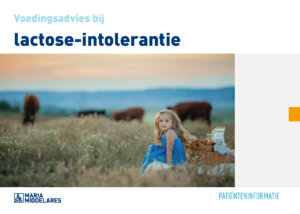Lactose intolerance
Symptoms and causes
Symptoms and causes- Lactose intolerance is not a food allergy.
- Lactose intolerance can be a trigger of irritable bowel syndrome.
- Lactose malabsorption can be a consequence of gluten hypersensitivity.
What is it?
Lactose is a sugar mainly present in milk and dairy products. Lactose consists of two components, namely galactose and glucose.
Under normal circumstances, lactose separates into glucose and galactose at the small intestine through an enzyme (i.e. lactase). Both end up in the blood through the intestine.
Lactose malabsorption occurs when the enzyme activity is insufficient to separate the lactose. Lactose consequently ends up in the colon in an undigested state, where it is broken down by the intestinal bacteria. This degradation process gives rise to the symptoms of lactose intolerance.
What is the difference between lactose malabsorption and intolerance?
Lactose malabsorption indicates insufficient absorption of lactose at the level of the small intestine, so that it ends up undigested in the large intestine.
Lactose intolerance indicates the inconveniences and symptoms associated with the consumption of milk and dairy products. This is usually due to lactose malabsorption, but not always. Sometimes lactose malabsorption does not cause any symptoms.
Complaints and symptoms
Symptoms of patients who have lactose intolerance often include:
- stomach cramps
- diarrhoea
- flatulence
- bloated feeling
Diagnosis and treatment
Diagnosis and treatmentTesting of lactose malabsorption
The Gastrointestinal Diseases Department uses the hydrogen breath test. The patient takes labelled lactose and then blows it into a bag every 15 minutes. This procedure takes about three hours.
Treatment
.Avoid foodstuffs containing lactose
- Read the packaging and pay attention to words like ‘lactose’, ‘dry milk powder’ and ‘whey powder’
- Some products may be well tolerated if the quantity absorbed at once is not too great.
Lactose is mainly found in:
- dairy products (milk, cream, soft cheese, etcetera)
- milk bread, sultana bread, sandwiches, croissants, coffee cakes, rusks, toast, etc.
- pastries, biscuits, waffles, pancakes...
- chocolate (white and milk), candy, etc.
- sauces, soups...
- all kinds of ready-made dishes
- medication, vitamin preparations
- cornstarch, pudding powder...
- sausage, hamburger, minced meat, pâté, salami, beef tartare...
- ice cream
- butter, some types of margarine
Advice from a dietitian is certainly useful. For this, you can contact the dietitians of our hospital:
Supplements
There are enzyme supplements that can be taken with foods containing lactose. Enzyme supplements aid in the digestion of the food. Sometimes, extra calcium and vitamin D supplements are recommended.
Downloads
DownloadsOnly available in Dutch:

Voedingsadvies bij lactose-intolerantie
DownloadTreatment centres and specialisations
Treatment centres and specialisations
Latest publication date: 15/05/2024
Supervising author: Dr Monsaert Els







